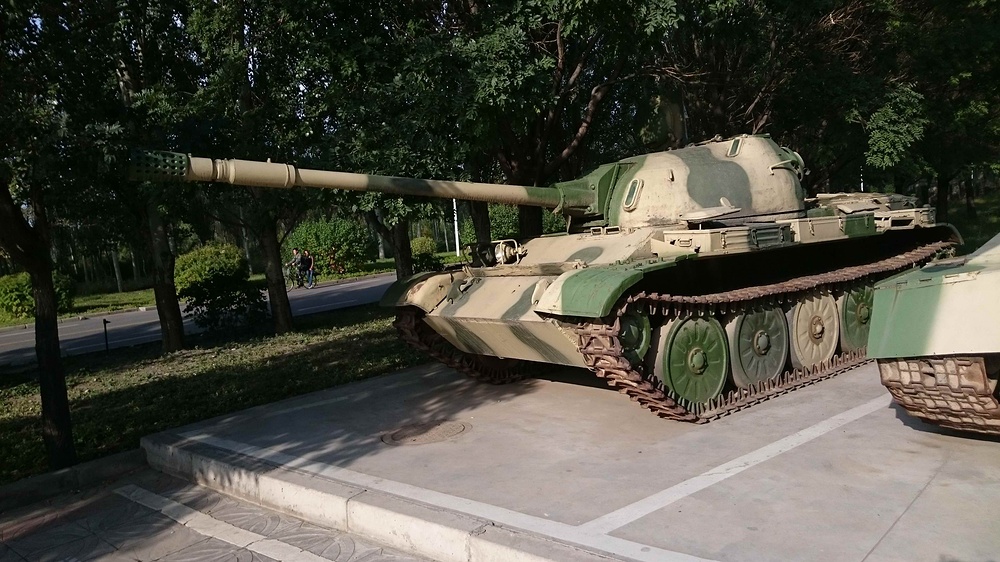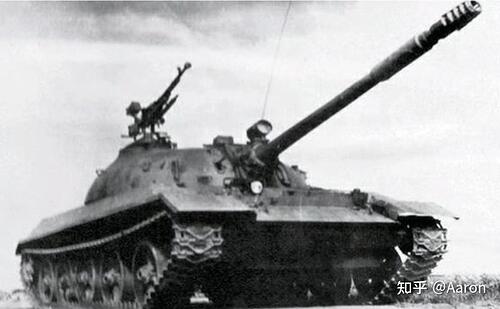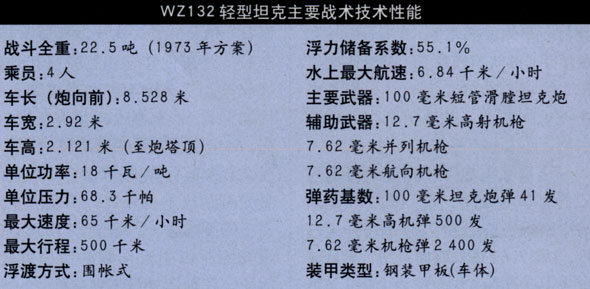- Yes
- No

TL;DR: Light tank prototype derived from the Type 62, armed with a stabilised 100mm smoothbore and a laser rangefinder. Erroneously known as ‘WZ-132’.
History
The Type 62 (ZTQ62) was developed in the late 1950s and early 1960s, as a light tank designed to operate in terrain the heavier Type 59 MBTs couldn’t, particularly around southern China. Work on a light tank began in 1956, and two separate competitor designs were made. A 16-tonne design was called 59-16, and a 24-tonne design was called 131. The 131 was further developed into the 132 (132 (1959) and 132 (1960) / 132A). Both the 132 (1959) and 132 (1960) were armed with a 76mm cannon. This cannon was deemed inadequate, and it was replaced with an 85mm cannon on the 132B. After further testing and minor changes, the 132B entered production and service as the Type 62 in 1963. Production ended in 1982, with a total of 1,560 vehicles produced.
1. Type 62; 2. 132 (1959)
In 1967, discussions began on the development of an improved ‘second-generation’ light tank, due to the shortcomings of the Type 62. The name of the improved vehicle was 132 — a preliminary design stated it should have an improved 85mm cannon, a laser rangefinder, and a new engine, as well as improved suspension and fire-control system. It is important to note the 132 was not a direct continuation of the Type 62 prototypes that were also designated 132. It is also important to note that the 132 is not designated WZ-132 as it is often referred to as online. ‘WZ’ only started to be used in the 1980s, after the development of this vehicle was cancelled, and ‘WZ’ was not retroactively applied to old prototypes.
In 1969, China and the USSR had a 7-month border conflict. The USSR’s T-62 was deemed superior to all Chinese equipment at the time (Type 59 MBTs + Type 56 RPG). This spurred research into a 100mm smoothbore cannon for the 132, to be able to penetrate the T-62’s armour. In 1970, orders were issued for the development of five new ‘second-generation’ tanks, including MBTs (122-series) and light tanks. Partly due to the Cultural Revolution at the time, a series of unrealistic demands were made for the 132. It was to weigh only 18–20t (The Type 62 weighs 21t), be armed with a lightweight 100mm smoothbore ale to fire APFSDS rounds, have 4 ATGM launchers, have a thermal gunner’s sight, a laser rangefinder, and CITV, and have dual-axis stabilisation. It was also to have a 450hp engine and use ‘three-liquid’ technology (hydraulic transmission, hydraulic power steering, and hydropneumatic suspension capable of tilting the tank in all four directions).
The first prototype was constructed by September 1970. It featured an 8V150 engine, hydropneumatic suspension, 4 ATGM launchers, and a 100mm cannon. It, however, was not anywhere near as advanced as was previously called for. The unrealistic targets were subsequently adjusted for the next prototypes. Two more prototypes were built in January and March of 1971. They featured a 12150L-7 engine (the same as on the Type 59), hydraulic steering but not hydropneumatic suspension (instead using torsion bars), reduced turret height, removed stabiliser, and the 4 ATGM launchers. The two prototypes underwent extensive tests, firing 234 shells. The original 1970 prototype was also still being tested after some changes were made to its hydropneumatic suspension. A fourth prototype was constructed in 1972 with further changes. It featured the 100mm smoothbore, an IR spotlight, a laser rangefinder, and night vision sights, lacking the hydraulic systems and the ATGM launchers.
This appears to be one of only 2 images of the 132. Which prototype vehicle it represents is unclear, since it has the 12.7mm fitted to just the 1972 prototype, but has a different IR spotlight. Likewise, the other image lacks the 12.7mm but also lacks the ATGM launchers fitted to prototypes 1–3. It could be that both are the 1972 prototype at different times.
In 1973, the prototype underwent fire testing, firing a total of 77 shells. Later, the ballistic computer and stabiliser were test-fitted and 9 shells were fired — it worked, but had fairly low accuracy. In 1974, the 100mm smoothbore was deemed insufficient against Soviet tanks, which at that point included the new T-72. Given that a multitude of problems still persisted, including the low accuracy of the ballistic computer and problems with the stabiliser, the 132 light tank was shelved, and focus was instead placed on upgrading the Type 62. This included fairly impromptu laser rangefinders in the late 1970s, and a more comprehensive upgrade package in the 1980s (LRF, slat armour, sideskirts), but nothing on the same level as the 132.

Late model Type 62.
Characteristics
The 132 (1972) is armed with a 100mm lightweight smoothbore cannon derived from the 100mm Type 69, shortened to roughly the same length as the original 85mm Type 63 cannon. It has a two-plane stabiliser, and can fire the same rounds as the Type 69 (although, presumably at a lower velocity). Type 71 APFSDS penetrates 219mm @ 0° @ 10m, and Type 73 HEAT-FS penetrates 390mm @ 0° @ 10m. 41 rounds are carried, with a 4 in a ready-rack in the rear of the turret.
The 132 (1972) has an internal laser rangefinder. It also has a 12.7mm Type 54 HMG on the turret, with 500 rounds of ammunition, and a coaxial 7.62mm Type 59 with 2400 rounds of ammunition.
Specifics of the 132’s armour are lacking, but it appears to be basically identical to the Type 62. The Type 62’s hull armour is 35mm across the UFP, 25mm along the sides, and 15mm along the rear. The turret is slightly better protected, at 50mm frontally, 35mm along the sides, and 32mm at the rear.
The 132 (1972) is fitted with the 12150L-7 V12 diesel engine, producing 520hp. It could reach a top speed of 65km/h. It weighs around 22.5t, giving it a power-to-weight ratio of 23.1hp/t.
Conclusion
The 132 (1972) would be an excellent addition to China’s light-tank line, featuring the 100mm cannon of the Type 69 on a more mobile chassis. It would likely go at a BR of around 8.3, with a similar role as the Soviet Object 685, but slightly less mobile and with worse rounds.
Specifications
Armament
- Lightweight 100mm
- Stabilised
- 41 rounds
- Type 71 APFSDS
- 219mm at 0° at 10m
- Type 73 HEAT-FS
- 390 at 0°
- Type 71 HE
- 26mm at 0°
- 1x 12.7mm Type 54
- 500 rounds
- 1x 7.62mm Type 59
- 2400 rounds
- Laser rangefinder
Armour
- Turret
- 50 / 35 / 32mm (Estimate)
- Hull
- 35 / 25 / 15mm (Estimate)
Mobility
- Speed
- 65km/h
- Weight
- 22.5t
- Engine power
- 520hp, 23.1hp/t
Other
- Crew
- 4
Images
Spoiler
No other images appear to exist

Sources




